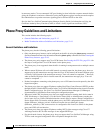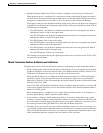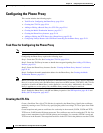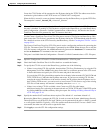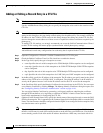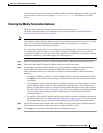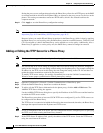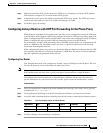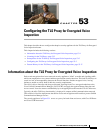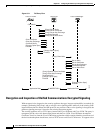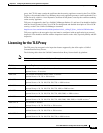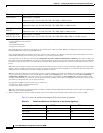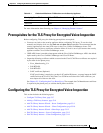
52-20
Cisco ASA 5500 Series Configuration Guide using ASDM
Chapter 52 Configuring the Cisco Phone Proxy
Configuring the Phone Proxy
Setting the proxy server configuration option for the Phone Proxy allows for an HTTP proxy on the DMZ
or external network in which all the IP phone URLs are directed to the proxy server for services on the
phones. This setting accommodates nonsecure HTTP traffic, which is not allowed back into the
corporate network.
Step 11 Click Apply to save the Phone Proxy configuration settings.
Note After creating the Phone Proxy instance, you enable it with SIP and Skinny inspection. See SIP
Inspection, page 48-24 and Skinny (SCCP) Inspection, page 48-37.
However, before you enable SIP and Skinny inspection for the Phone Proxy (which is done by applying
the Phone Proxy to a service policy rule), the Phone Proxy must have an MTA instance, TLS Proxy, and
CTL file assigned to it before the Phone Proxy can be applied to a service policy. Additionally, once a
Phone Proxy is applied to a service policy rule, the Phone Proxy cannot be changed or removed.
Adding or Editing the TFTP Server for a Phone Proxy
Note This feature is not supported for the Adaptive Security Appliance version 8.1.2.
Note You can edit the TFTP server setting by using the Edit TFTP Server dialog box; however, changing a
setting in this dialog box does not change related settings for the phone proxy. For example, editing the
IP address for the TFTP server in this dialog does not change the setting in the CTL file and does not
update the address translations required by the phone proxy.
To modify TFTP server settings, we strongly recommend you re-run the Unified Communications
Wizard to ensure proper synchronization with all phone proxy settings.
Step 1 Open the Configuration > Firewall > Unified Communications > Phone Proxy pane.
Step 2 Check the Enable Phone Proxy check box to enable the feature.
Step 3 To add or edit the TFTP Server information for the phone proxy, click the Add or Edit button. The
Add/Edit TFTP Server dialog box appears.
Use the Add/Edit TFTP Server dialog box to specify the IP address of the TFTP server and the interface
on which the TFTP server resides.
The Phone Proxy must have at least one CUCM TFTP server configured. Up to five TFTP servers can
be configured for the Phone Proxy.
The TFTP server is assumed to be behind the firewall on the trusted network; therefore, the Phone Proxy
intercepts the requests between the IP phones and TFTP server.
Note If NAT is configured for the TFTP server, the NAT configuration must be configured prior to specifying
the TFTP server while creating the Phone Proxy instance.
Step 4 In the TFTP Server IP Address field, specify the address of the TFTP server. Create the TFTP server
using the actual internal IP address.



